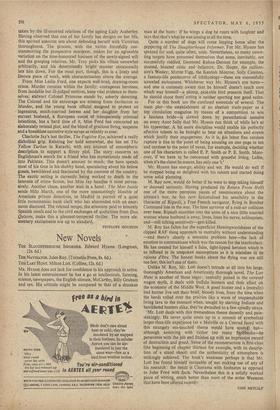New Novels
MR. HYAMS does not lack for confidence in his approach to satire. In his latest entertainment he has a go at intellectuals, farming, science, newspapers, the English climate, McCarthy, Billy Graham and sex. His attitude might be compared to that of a drunken
man at the butts : if he wings a dog he roars with laughter and says that that's what he was aiming at all the time.
Quite a number of dogs will come limping home after the peppering of The Slaughterhouse Informer. For Mr. Hyams has sprayed far and, quite often, wide. Nevertheless, so many unwit- ting targets have presented themselves that some, inevitably, are successfully riddled. Desmond Rohan-Dermot for example, the stunted, bloated critic and belletrist; Dr. Sloper, the million- aire's Wesley; Myrne Figg, the Kentish Monroe; Solly Canston, a fantasy-life pontecorvo of ichthyology—these are successfully scrawled caricatures. Whichever way Mr. Hyams's eye turns— and one is curiously aware that he himself doesn't much care which way himself—a plump, pinkable bird presents itself. That he should shoot them sitting is neither sporting nor good satire.
For in this book are the confused essentials of several. The main plot—the establishment of an abattoir trade-paper as a top circulation magazine by means of a competition to win a luscious bride—is slowed down by parenthetical assaults on every Aunt Sally that Mr. Hyams can think of while he's at his typewriter. A bit more discipline would enable his perfectly effective talents to be brought to bear on situations and events which justify their engagement. As it is, his latest fine careless rapture is fine to the point of being amusing on one page in ten and careless to the point of never, for example, deciding whether one of his characters is called E. P. Smith or P. E. Smith. More- over, if We have to be concerned with graceful living, Lafite, when it's the claret he means, has only one 't.'
Mr. Hyams has energy, ability and wit. He would do well if he stopped being so delighted with his talents and started doing some solid planning.
M. Roy now, would do better if he were to stop taking himself so damned seriously. Having produced (in Return From Hell) one of the more pompous pieces of reminiscence about the airman's war, he has now fictionalised his sensibility in the character of Ripault, a Free French navigator, flying in Bomber Command late in the war. The lone survivor of a mid-air collision over base, Ripault stumbles into the arms of a nice little married woman whose husband is away, loves, loses his nerve, soliloquises, and—still talking sensitively—gets killed.
M. Roy has fallen for the superficial Hemingwayishness of the clipped RAF slang approach to mortality without understanding —and there's clearly a semantic problem here—the lack of emotion to communicate which was the reason for the inarticulacy. He has created for himself a false, tight-lipped heroism which is as inflated in its unspoken assumptions as it is mistaken in its raisons d'être. The honest books about the flying war are still too few; this isn't one of them.
Unlike M. Roy, Mr. Lott doesn't intrude at all into his large, thoroughly American and Americanly thorough novel. The Last Hunt is another of those sagas: centrally poised in the covered wagon myth, it deals with buffalo hunters and their effect on the economy of the Middle West. A good hunter and a (morally) bad hunter live out their brief, bloody lives, from the time when the herds rolled over the prairies like a wave of unquenchable living lava to the moment when, sought by starving Indians and bewildered hunters alike, they've dwindled to a few spindly strays.
'Mr. Lott deals with this tremendous theme decently and pain- stakingly. He never quite soars up to a summit of symbolical larger-than-life experience (as a Melville or a Conrad faced with this strangely sea-touched theme would have soared) but— although annoying with rather too many flashbacks—he perseveres with the job and finishes up with an impressive record' of destruction and greed. Some of the reconstruction is first-class (the beginning of chapter thirteen for example, with its descrip- tion of a stand shoot) and the authenticity of atmosphere is strikingly achieved. The book's weakness perhaps is that Mr. Lott has found himself incapable of not making use of any of his research : the result is Cinerama with footnotes as opposed to John Ford with facts. Nevertheless this is a solidly worked piece of writing, much better than most of the artier Westerns that have been offered recently










































 Previous page
Previous page